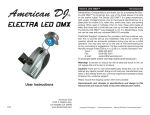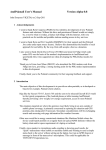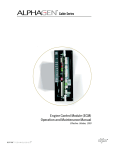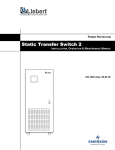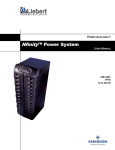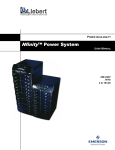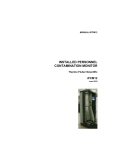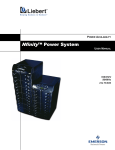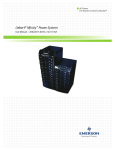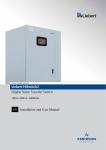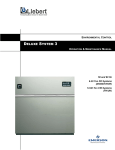Download Emerson Liebert Static Transfer Switch Specifications
Transcript
CSI 16262 - Static Transfer Switches Liebert Static Transfer Switch 2 Automatic Static Transfer Switch GUIDE SPECIFICATIONS for 100A – 1000A 1.0 GENERAL 1.1 SUMMARY These specifications describe the requirements for an automatic static transfer switch (STS). The STS is a solid-state, three-pole, dual-position transfer switch designed to automatically and manually switch between two synchronized three-phase AC power sources without an interruption of power to the load longer than 1/4 cycle. The input power shall be supplied from two different AC power sources, which are nominally of the same voltage level, phase rotation, and frequency. The primary purpose of the STS is to allow virtually uninterrupted transfer from one source to the other in case of failure of one source or by manual initiation for test or maintenance. The switching action shall not connect together the two sources of power that would allow back feeding one source to the other. The STS shall allow for either source to be designated as the “preferred source” to which the switch will automatically transfer to and remain transferred to until manually initiated to transfer or until the selected source fails, at which time, the STS shall transfer without interruption greater than 1/4 cycle to the other source, or “alternate source”. The STS shall be furnished with key-interlocked static switch isolation and bypass breakers to each source which allow uninterrupted manual transfer to and from either source for maintenance. 1.2 STANDARDS The specified system shall be designed, manufactured, tested, and installed in accordance with: • American National Standards Institute (ANSI) • Canadian Standards Association (CSA) • Institute of Electrical and Electronics Engineers (IEEE) • ISO 9001 • National Electrical Code (NEC) • National Electrical Manufacturers Association (NEMA) • National Fire Protection Association (NFPA) • Underwriters Laboratories (UL) (ULc) • EN 50091-2 • EN 61000-6-3 & 6-2 • EN 60947-6-1 • IEC 62310 SL-20610 (R 11/02) 1 Liebert Static Transfer Switch The STS shall be UL and UL listed per UL Standard 1008 for Automatic Transfer Switches. The STS shall comply with the latest FCC Part 15 EMI emission limits for Class A computing devices and the emission limits of EN50091-1, 2, 3 Class A. The STS shall safely withstand without misoperation or damage: • Transient voltage surges on either AC power input as defined by ANSI/IEEE C62.41 for Category B3 locations (high surge exposure industrial and commercial facilities) • Electrostatic discharges (ESD) up to 10 kV at any point on the exterior of the unit • Electromagnetic fields from portable transmitters within 3 feet (1 meter) of the unit The STS2 shall comply with the immunity requirements of EN50082-1. 1.3 Definitions STS - Static Transfer Switch SCR – Silicon Controlled Rectifier MTBF – Mean Time Between Failure is the actual arithmetic average time between failures of the critical AC output bus. Non-automatic circuit breaker – A circuit breaker which has no automatic thermal overload trip element but does have a magnetic trip element for short-circuit/fault protection. Short-circuit and overload protection must be provided by an upstream overcurrent device. 1.4 SYSTEM DESCRIPTION 1.4.1 Design Requirements A. Voltage. Input/output voltage specifications of the STS shall be [(200) (208) (220) (240) (380) (400) (415) (480) (600) ( )]volts, three phase, (60) (50) Hz, (3) (4)-wire plus ground. B. Output Load Capacity. Specified output load capacity of the STS shall be (100) (250) (400) (600) (800) (1000)A. The STS shall be continuous rated to carry a full 100% load. 1.4.2 Modes of Operation The Static Transfer Switch shall be a three-pole, double-throw, solid-state, automatic transfer switch that is fed from two AC power sources. One source shall be designated as the preferred source while the other is the alternate source. Selection of which input source is preferred shall be user selectable from the operator control panel. All transfers shall be a fast break-before-make with no overlap in conduction from one source to the other. All transfers, including sense and transfer times, shall have less than a 1/4 cycle interruption in power to the load. The Static Transfer Switch is fuseless and consist of 6 pairs of Silicon Controlled Rectifiers (SCRs) connected in an AC switch configuration. The brick type SCRs are continuous rated to carry 100% the STS rated load while operating within the STS specifications. The use of fuses for protection is not permitted due to possible fuse clearing in an out of phase transfer. The Static Transfer Switch logic power shall automatically power up when connected to the power source. The control panel shall be active as long as one input to the STS is energized. The STS shall be supplied with factory default settings; mechanical trim pots shall not be used for calibration or adjusting 2 Guide Specification 100 – 1000 Amps settings. All setting must be adjustable; the settings shall be adjusted/configured from the LCD display. A. Normal Mode. The unit is fed by two sources with the output connected to the load. In normal operation, the load shall be connected to the preferred source as long as all phases of the preferred source are within the acceptable limits. Upon failure of the preferred source, the load shall be transferred to the Liebert Static Transfer Switch 2 Guide Specifications alternate source until such time as the preferred source returns to within the acceptable limits. Transfer voltage limits shall be +/- 10% of the nominal input voltage for steady state conditions, with low voltage transfer limits having an inverse time relationship that is within the IEEE Std. 446 computer voltage tolerance envelope. After the preferred source returns to within the acceptable voltage limits for at least the preset adjustable retransfer time delay (typically 3 seconds) and is in phase with the alternate source, the load shall be retransferred automatically to the preferred source. The automatic retransfer to the preferred source can be disabled if so selected by the user from the operator control panel. When the automatic retransfer is disabled, emergency transfers from the alternate source to the preferred source shall not be disabled upon alternate source failure. B. Load Current Inhibit. The STS shall sense the load current and, if the load current exceeds an adjustable preset level deemed to represent a load inrush or fault condition, the STS shall disable the automatic transfer even if the voltage on the selected source exceeds the transfer limits. The load current transfer inhibit shall be [(automatically) (manually)] reset after the current returns to normal to allow for continued protection against a source failure. C. Manual Transfer. The STS shall allow manually initiated transfers between the two sources, providing the alternate source is within acceptable voltage limits and phase tolerances with the preferred source. Allowable phase differences between the sources for manually initiated transfers shall be adjustable from the operator control panel. The STS shall be capable of tolerating transfers up to 180 degrees out of phase for emergency conditions. However, the user-adjustable phase synchronization window shall be limited to +/- 30 degrees. If the transfer is manually initiated, the STS shall transfer between the two sources without interruption of power to the load greater than 1 millisecond provided that both sources are available and synchronized within the user-adjustable phase synchronization window. For sources where the two frequencies are not exactly the same (as would be the case between a utility and standby generator source), manually initiated transfers shall be delayed by the STS until the two sources are within the user-adjustable phase synchronization window. D. Emergency Transfer. In an effort to maintain power to the load, upon loss of the source that the load is connected to, the STS shall automatically transfer to the other source in less than 1/4 cycle, overriding any retransfer time delays or other inhibits except load overcurrent providing that the other source is available. If one source is shorted upstream which causes an under voltage condition on that source, the STS will sense the under voltage and transfer to the alternate source. E. SCR Failure. The STS shall continuously monitor the status of the SCR switching devices for proper operation. In the event of a shorted SCR on the source powering the load, the STS shall automatically alarm the condition and trip open the other source isolation breaker. In the event of a shorted SCR on the other source, the STS shall automatically alarm the condition and trip open the other source isolation breaker. In the event of an open SCR, the switch shall automatically alarm the condition, transfer to the other source and trip open the previous source isolation breaker. All open and shorted SCR alarm conditions shall be latched and require the system to be repaired and reset to restore normal operation. F. Maintenance Bypass. The STS shall be furnished with key-interlocked maintenance bypass breakers that allow the STS power, controls and monitoring electronics to be bypassed to either input source for maintenance without interruption of power to the load. The packaging of the STS shall have all electronics isolated from the input, output, and bypass connections to allow safe servicing of any SL-20610 (R 11/02) 3 Liebert Static Transfer Switch components without access to hazardous voltages when the unit is in maintenance bypass. 1.4.3 Performance Requirements A. Nominal Input/Output Voltage: [(200) (208) (220) (240) (380) (400) (415) (480) (600) ( )] volts three phase, [(3) (4)]-wire-plus-ground. B. Voltage Range: +10%, -10% of nominal C. Frequency: (50) (60) Hz. +/-0.5 Hz D. Maximum Continuous Current: [(100) (250) (400) (600) (800) (1000)] amps E. Load Power Factor Range: 0.75 to 1.0, leading or lagging. F. Load Crest Factor: Up to 3.5. G. Source Voltage Distortion: Up to 10% THD with notches and ringing transients. H. Surge Protection: Sustains input surges without damage per criteria listed in ANSI C62.41 Category A and B. I. Sensing and Transfer Time: 4ms J. Overload Capability: 125% for 30 minutes (100-400A), 125% for 10 minutes (600 1000A) 150% for 2 minutes, 500% for 0.25 seconds K. Short Circuit Withstand Capability: 208-240V 380-480V 600V 100-250A 100kA 65kA 25kA 400-600A 100kA 100kA 25kA 800-1000A 100kA 65kA 42kA 1.4.4 Environmental Conditions A. Storage Temperature Range: -40° to +80°C (-40° to 176°F) B. Operating Temperature Range: 0° to 40°C (32° to 104°F). C. Relative Humidity: 0 to 95% without condensation. D. Operating Altitude: Up to 4000 feet (1200 meters) above sea level without derating. Above 4000 feet (1200 meters), output current is derated by 6% per 1000 feet (18% per 1000 meters). E. Storage/Transport Altitude: Up to 40,000 feet (12,200 meters) above sea level. F. Audible Noise: Less than 55 dBA at 5 feet (1.5 meters) with audible alarm off. 1.4.5 RELIABILITY 1.4.5.1 MTBF The STS shall be designed for high reliability and high availability with an MTBF exceeding 1,000,000 4 Guide Specification 100 – 1000 Amps hours. To the fullest extent practical, redundant circuits and components shall be used to eliminate single points of failure. 1.4.5.2 Power Supply Redundant power supplies shall be provided to prevent any single-point power supply failure mode. The STS shall have two completely separate power supplies mounted on separate boards so a power supply can be replaced while the load is on bypass. There shall be two separate DC buses, one from each power supply, to provide redundancy through out the controls. 1.4.5.3 Logic Control logic shall be triple redundant. Each of the three logic modules shall have it’s own separate power connection to each power supply bus. Each logic module shall be fused to prevent it from shorting the power supplies if an internal failure occurs. Gating and control logic shall be partitioned so that failure of one source’s gating or sensing logic does not prevent the switch from transferring to the other source. 1.4.5.4 Components All electrical components requiring normal maintenance or repair shall be replaceable without deenergizing the load, assuming that at least one source is available. Solid-state switching devices shall be packaged to allow safe repair of the switching devices without having to de-energize the load. All molded case switches or non-auto circuit breakers shall be of a plug-in or draw-out type to allow replacement without de-energizing the load. All control and logic components shall be mounted separate from the power components. 1.4.5.5 Fuseless No fuses are to be used to protect the solid-state power switching devices. All solid-state power switching devices shall be rated to prevent hazardous device failure in power systems with available fault currents up to [(100,000 amps @208V)(65,000 amps @480V) (25,000 amps @ 600V)]. 1.4.5.6 Access The STS shall be designed for front access only. The STS shall be designed so all installation, repairs and maintenance can be done from the front or top of the unit. The STS shall be designed to minimize the exposure of hazardous voltages to allow safe servicing of the unit while the load is energized. Barriers shall be used on and round customer connections to protect personnel during maintenance. 1.5 DOCUMENTATION 1.5.1 Equipment Manual The manufacturer shall furnish an installation, operation and maintenance manual with installation, startup, operation, and maintenance instructions for the specified system. 1.5.2 Proposal Submittals Submittals with the proposal shall include: • A system one-line diagrams. • Outline drawing including weights, dimensions, heat dissipation, and recommended service clearances. • Location and detailed layouts of customer power and control connections. SL-20610 (R 11/02) 5 Liebert Static Transfer Switch • Description of equipment to be furnished, including deviations from these specifications. 1.5.3 Delivery Submittal Submittals upon STS delivery shall include a complete set of submittal drawings and one (1) installation, operation and maintenance manual that shall include a functional description of the equipment with block diagrams, safety precautions, instructions, step-by-step operating procedures and routine maintenance guidelines, including illustrations. 1.5.4 Spare Parts A list of recommended spare parts shall be furnished upon request. 1.5.5 User’s List An in-service user’s list shall be furnished upon request. 1.6 WARRANTY The manufacturer shall provide a warranty against defects in material and workmanship for 12 months after initial system start-up or 18 months after ship date, whichever occurs first. (Refer to the Warranty Statement for details.) 1.7 QUALITY ASSURANCE 1.7.1 Manufacturer Qualifications A minimum of five year’s experience in the design, manufacture, and testing of STS systems is required The specified system shall be completely factory-tested before shipment. Testing shall include, but shall not be limited to: quality control checks, “Hi-Pot” test (two times rated voltage plus 1000 volts, per UL requirements), transfer tests, and metering calibration tests. The system shall be designed, manufactured, and tested according to world class quality standards. The manufacturer shall be ISO 9001 certified. 1.7.2 Factory Testing Before shipment, the manufacturer shall fully and completely test the STS to assure compliance with the specifications. 2.0 PRODUCT 2.1 FABRICATION 2.1.1 Materials All materials of the STS shall be new, of current manufacture, high grade and free from all defects and shall not have been in prior service except as required during factory testing. The maximum working voltage, current and di/dt of all solid-state power components and electronic devices shall not exceed 75% of the ratings established by their manufacturer. The operating temperature of solid-state component sub-assembly shall not be greater than 75% of their ratings. 2.1.2 Wiring Wiring practices, materials and coding shall be in accordance with the requirements of the National Electrical Code (NFPA 70). All bolted connections of bus bars, lugs, and cables shall be in accordance with requirements of the National Electrical Code and other applicable standards. All electrical power connections are to be torque to the required value and marked with a visual indicator. 6 Guide Specification 100 – 1000 Amps Provision shall be made for power and control cables to enter or leave from the top or bottom of the STS cabinet. 2.1.3 Frame and Enclosure The STS unit comprises of solid-state, three-pole, dual-position transfer switch, key-interlocked static switch isolation and bypass breakers, shall be housed in a single free-standing NEMA type 1 enclosure and meet IP20 requirements. The frame shall be constructed of galvanized steel and pop riveted to provide a strong substructure. The frame shall include four heavy-duty swivel castors for ease of installation and four permanent leveling feet for final installation. Doors and removable exterior panels shall be a minimum of 16GA steel and be powder-painted the manufacturer’s standard color textured enamel finish paint. Key lock hinged front door shall provide access to the circuit breakers. A tool shall be required to remove exterior panels that expose hazardous voltages. All removable panels shall be grounded to the frame for safety and EMI/RFI protection. The cabinet shall be structurally designed to handle fork lifting from the base. Front access only shall be required for expedient servicing, maintenance, and installation. The STS shall be constructed of replaceable subassemblies that can be easily changed without exposing personnel to high voltage. Printed circuit assemblies shall be plug connections. Removable conduit/cable termination plates shall be provided in the top and bottom of the unit for termination of the two source input and/or output conduits, raceways or cables. The complete STS shall have maximum dimensions of [30 in./610 mm (up to 250 amps), 38 in./810 mm (400A–600A,), 84 in./2134 mm (800A–100A)] wide by 32 in./810 mm deep by 77 in./1950 mm high. The distributed floor weight shall be less than 150 lbs./sq. ft. (660 kg/m2). The STS can be tipped 15 degrees in any direction without falling over. 2.1.4 Cooling (100-600A) The STS shall utilize convection air cooling for the enclosure with forced air cooling of the heat sinks. All fans shall be redundant so that a single fan failure will not cause temperature to increase beyond acceptable limits. Heat rejection shall be through screened protective openings in the top of the unit. Air filters shall be located in the front door at the point of air inlet. Cooling (800-1000A) Cooling of the STS shall be by forced air. Low-velocity fans shall be used to minimize audible noise output. All fans shall be redundant so that a single fan failure will not cause temperature to increase beyond acceptable limits. Heat rejection shall be through screened protective openings in the top of the unit. Air filters shall be located in the front door at the point of air inlet 2.1.5 Grounding The STS shall operate from sources that are solidly or impedance grounded. Unit shall not be used on corner-grounded delta systems. The AC output neutral shall be electrically isolated from the STS chassis. The STS chassis shall have an equipment ground terminal. 2.2 COMPONENTS 2.2.1 Non-automatic Circuit Breakers SL-20610 (R 11/02) 7 Liebert Static Transfer Switch The STS shall be equipped with 5 molded-case, plug-in, non-automatic circuit breakers. The breakers shall be UL listed and IEC rated for use at the system voltage. The plug-in feature of the breaker shall include interlock, which prevents the breaker from being unplugged without being in the “Off” (open) position. Three of the breakers shall provide for total isolation of the solid-state switching devices with an input breaker for each source and a load isolation breaker. Two of the breakers shall provide for maintenance bypassing of the solid-state switching devices to either input source. Key interlocks shall be provided on the breakers to prevent improper maintenance bypassing of the solid-state switch. A bypass breaker can not be closed unless the solid-state switch is connected to the same input source and only one bypass breaker can be closed at a time. All breakers shall be equipped with N.O. and N.C. auxiliary switches for monitoring of the breaker positions. The two input breakers for the solid-state switching devices also shall be equipped with 48 VDC shunt trips to allow for control by the STS logic. 2.2.2 Silicon Controlled Rectifiers (SCRs) The STS consist of six pairs of SCRs connected in an AC switch configuration. The SCRs shall be bricktype and rated to carry the full 100% rated load. The SCRs shall be rated to prevent hazardous device failure in power systems with available fault currents listed in section 1.4.3.K. 2.2.3 Control Panel The STS shall be provided with a microprocessor based control panel for operator interface to configure and monitor the STS. The control panel shall be located on the front of the unit and can be operated without opening the hinged front door. The display shall not be mounted to the front door so the door can be easily removed for maintenance. A back-lit, menu-driven, full graphics, color touch-screen Liquid Crystal Display (LCD) shall be used to display system information, status information, a one-line diagram of the STS, active alarms, alarm history information, startup and bypass instructions. No mechanical pushbuttons shall be used. The mimic panel screen shall indicate the power flow, the status of all molded-case non-automatic circuit breakers, the preferred source, and the STS position (connected to source 1 or 2) as well as active alarms. Pop up boxes selected from the menu bar shall be provided for operator interface to the LCD control panel for menu selection, control of the preferred source, manual transfer initiation, auto/manual retransfer selection, and other system setpoints. In addition, by touching the screen you can silence and reset the audible alarm. To facilitate STS operation, help test, step-by-step start-up, transfer, and maintenance bypass procedures shall be displayed on the LCD screen. For manual transfers, a syncscope shall display the leading or lagging real-time phase difference between the two input sources. The control panel shall be equipped with an internal RS232 port and Flash memory to allow the STS software to be upgraded by a factory trained customer engineer without shutting down the load. To facilitate diagnostics, an event log of the last 512 alarm events shall be stored in non-volatile memory and displayed on the LCD. Two history logs each having 64 frames of unit status frozen upon an alarm condition designated, as a “freeze fault” will be stored in non-volatile memory and displayable on the LCD. A frame shall be acquired every 4 milliseconds, with 40 frames before the fault and 23 frames after the fault. Each frame contains metering data, active alarms/faults, and unit status. A system calendar and real time clock shall be included to time-stamp all stored events. Monitored parameters shall be acquired two times per 4-millisecond frame. CAN bus shall be used to communicate between the logic and the control panel as well as the options. For remote monitoring, a serial RS-232 port shall provide present switch status information, alarm history information, and the history of status screens that are triggered upon a major alarm event. 8 Guide Specification 100 – 1000 Amps 2.2.2.1 Metering The following metering parameters shall be displayed: • Input AC voltage both sources, line-to-line for each phase • Input AC current for both sources for each phase • Input frequency for both sources • Output kVA • Output KW • Percent load • Number of switch transfers, • Synchronization phase angle All voltages and currents shall be measured using true-RMS techniques for accurate representation of non-sinusoidal waveforms associated with computers and other electronic loads. The metering parameters shall have a full-scale accuracy of +/-2%. 2.2.2.2 Alarm Messages Active alarms shall be monitored and displayed simultaneously as part of the LCD event panel. The following alarm messages shall be displayed: Source 1 Failure Source 2 Failure Sources Out of Sync Source 1 Overvoltage S1Undervoltage (fast) S1Undervoltage RMS (slow) CB1( Source 1) Open CB2 ( Source 2) Open CB3 (Output) Open CB3A Open (If used) CB4 (S1 Bypass) Closed CB5 (S2 Bypass) Closed Source 2 Overvoltage CB1 Shunt trip fail S2 Undervoltage (fast) S2 Undervoltage RMS (slow) Source 1 Overcurrent CB2 Shunt trip fail S1 SCR Open S2 SCR Open Source 2 Overcurrent S1 SCR Shorted Source 1 Over/Under Frequency Source 2 Over/Under Frequency Source 1 Phase Rotation Error Source 2 Phase Rotation Error Output undervoltage S2 SCR Shorted Power Supply S1 AC Failed Power Supply S2 AC Failed Power Supply DC A Failed Power Supply DC B Failed Power Supply Logic Failed S1 Voltage sense module failed S2 Voltage sense module failed S1 SCR sense module failed S2 SCR sense module failed S1 Current sense module failed S2 Current sense module failed S1 Gate drive module failed Primary fan failure S2 Gate drive module failed Control Module Fail S1 I-peak S2 I-peak STS on alternate source Transfer Inhibit Auto Retransfer Inhibit Internal comm failed Option comm failed Output voltage sense module failed Heatsink Overtemp SL-20610 (R 11/02) 9 Liebert Static Transfer Switch An audible alarm shall be activated when any of the alarms occurs. All alarms shall be displayed in text form. 2.3 ACCESSORIES (OPTIONAL COMPONENTS AND SERVICES) 2.3.1 Programmable Relay Board A Programmable Relay Board with eight sets of isolated Form C contacts shall be provided to indicate a change of status of any of the alarm conditions. Any alarm can be programmed onto any channel or channels. Up to two Programmable Relay boards can be installed in the STS2. Programming is performed through the Touch-screen display. Each contact shall be rated 1 Amp @ 30 VDC or 250mAmp @ 125 VAC. 2.3.2 Input Contact Isolator Board A Input Contact Isolator Board with eight relay inputs (normally open dry contacts) shall be provided for owner alarm messages. The owner through the touch-screen display can program the alarm messages. 2.3.3 Comms Board The STS shall be provided with a Comms Board that can communicate with a Liebert SiteScan monitoring system and/or an external modem. The STS shall be equipped with an RS-422 communication port for communication to a Liebert SiteScan monitoring system using a 2-wire twisted pair for reliable communication up to 1000 meters (3281 feet). Information available from the RS-422 port shall include the present switch status information, all monitoring parameters, and all active alarms. The STS shall be equipped with a modem interface for remote reporting of the present switch status information, alarm history information, and the history of status screens that are triggered upon a major alarm event. The monitoring system software shall also support an auto-dial feature that allows the system to automatically dial programmed phone numbers by way of the modem to report designated alarm conditions. (External modem is supplied by others) 2.3.4 Comms Board with Internal Modem The STS shall be provided with a Comms Board that can communicate with a Liebert SiteScan monitoring system and/or an internal modem. The STS shall be equipped with an RS-422 communication port for communication to a Liebert SiteScan monitoring system using a 2-wire twisted pair for reliable communication up to 1000 meters (3281 feet). Information available from the RS-422 port shall include the present switch status information, all monitoring parameters, and all active alarms. The STS shall have an internal modem capable of dialing out from the STS to notify up to two remote computers, terminals, PC’s, or pocket pagers when important events occur. The modem will also be capable of accepting incoming calls, with the appropriate security, and connecting to a remote terminal, computer or PC, to perform all those functions normally available on the front panel including viewing monitoring screens. 2.3.5 Network Interface Card (NIC) STS shall have an OpenComms Network card, which enables the STS to communicate to a network management system (NMS). The Network Interface Card (NIC) will include internal hardware and 10 Guide Specification 100 – 1000 Amps software to communicate (via SNMP and HTTP) to any I.P.-based Ethernet network through a RJ-45 connector. The NIC shall provide redundant paths for communications that make it possible to connect to a Building Management System (BMS) using Modbus while simultaneously communicating to a NMS through SNMP and HTTP. A terminal block shall be provided to connect to Modbus. 2.3.6 Remote Source Selection The STS shall be furnished with Remote Source Selection board to remote select the preferred source. Closure of one of the two NO dry contacts (by others) shall cause the selected source to be the preferred source to which the STS will connect the load to as long as the source is available in the same manner as the local source transfer selection. If both input contacts are closed, the current selected preferred source shall be retained. The unit preferred source selection and remote source selection shall be active at the same time, with the STS following the last request for a preferred source change, regardless of whether it was from the local or remote source select controls. 2.3.7 Key Lockout Switch A key lockout switch shall be provided which activates a software lockout of the touch-screen display to prevent manual transfers and configuration changes. When locked out the touch-screen becomes a read only display, a key is needed to do manual transfers or change settings. The alarm silence button shall not be disabled when in the lockout position. The switch shall be located behind the front door but can be operated without opening the front door. 2.3.8 Redundant Output Breaker A redundant output plug-in non-automatic circuit breaker shall be provided and connected in parallel with the output plug-in non-automatic circuit breaker to provide redundancy in the output power path. The redundant non-automatic circuit breaker shall be of the same rating and type as the output breaker. 2.3.9 Input Junction Boxes and Cables Two input power junction boxes and interconnecting cables shall be furnished for the input power connections. Power terminal blocks shall be provided in each input junction box for the connection of the input power conductors and a parity-sized ground conductor. The junction boxes shall be NEMA type 1 enclosure with maximum dimensions of 16 in. (406 mm) width, 30 in. (762 mm) length, and 6 in. (153 mm) height. An input cable assembly shall be provided for connection between the STS unit and the junction box. The cable length between the unit and junction box shall be 10 feet (3 m) long, and consist of the appropriate number and size of conductors inside UL/CSA listed liquid-tight, flexible metal conduit. The conductors shall be UL/CSA listed 90°C minimum insulation, copper conductors, sized in accordance with the NEC, based on the STS input breaker ampacity. 2.3.10 Seismic Floor Anchors The STS shall be provided with seismic floor anchors to fasten the unit to a concrete floor to meet seismic Zone 4 requirements. 2.3.11 Certified Test Report A certified copy of the factory test report shall be provided for each unit. 2.3.12 Factory Witness Test The owner and/or the owner’s representative shall factory witness test each unit. The factory will perform its standard witness test to demonstrate that the unit meets the STS specification. SL-20610 (R 11/02) 11 Liebert Static Transfer Switch 2.3.12 Export Crating Heavy-duty solid wood crating with vapor barriers and desiccant shall be provided to meet international requirements regarding package strength and markings for overseas shipments. 3.0 EXECUTION 3.1 FIELD QUALITY CONTROL The following inspections and test procedures shall be performed by factory-trained field service personnel during the STS startup. 3.1.1 Visual Inspection • Inspect equipment for signs of damage • Verify installation per drawings • Inspect cabinets for foreign objects • Verify neutral (if used) and ground conductors are properly sized and configured • Verify all printed circuit boards are configured properly 3.1.2 Mechanical Inspection • Check all control wiring connections for tightness • Check all power wiring connections for tightness • Check all terminal screws, nuts, and/or spade lugs for tightness 3.1.3 Electrical Inspection • Check all fuses for continuity • Confirm input voltage and phase rotation is correct • Verify control transformer connections are correct for voltages being used 3.2 MANUFACTURER’S FIELD SERVICE 3.2.1 Service Personnel The STS manufacturer shall directly employ a nationwide service organization, consisting of factory trained field service personnel dedicated to the start-up, maintenance, and repair of UPS and power equipment. The organization shall consist of regional and local offices. The manufacturer shall provide a fully automated national dispatch center to coordinate field service personnel schedules. One toll-free number shall reach a qualified support person 24 hours/day, 7 days/week, and 365 days/year. If emergency service is required, response time shall be 20 minutes or less. An automated procedure shall be in place to insure that the manufacturer is dedicating the appropriate technical support resources to match escalating customer needs. 3.2.2 Replacement Parts Stocking Parts shall be available through an extensive network to ensure around-the-clock parts availability 12 Guide Specification 100 – 1000 Amps throughout the country. Recommended spare parts shall be fully stocked by local field service personnel with back up available from national parts center and the manufacturing location. The national parts center Customer Support Parts Coordinators shall be on-call 24 hours/day, 7 days/week, and 365 days/year for immediate parts availability. Parts from the national parts center shall be shipped within 4 hours on the next available flight out and delivered to the customer’s site within 24 hours. 3.2.3 STS Maintenance Training Maintenance training courses for customer employees shall be available by the STS manufacturer. This training is in addition to the basic operator training conducted as a part of the system start-up. The training course shall cover STS theory, location of subassemblies, safety, and STS operational procedures. The course shall include control, metering, and feedback circuits to the Printed Circuit Board (PCB) level. Troubleshooting and fault isolation using alarm information and internal self-diagnostics should be stressed. 3.2.4 Maintenance Contracts A complete offering of preventive and full service maintenance contracts for the STS shall be available. An extended warranty and preventive maintenance package shall be available. Factory-trained service personnel shall perform warranty and preventive maintenance service. NOTE: These Guide Specifications comply with the format outlined by the Construction Specifications Institute per CSI MP-2-1 and CSI MP-2-2. Please refer to Document SL-20610, (11/02). SL-20610 (R 11/02) 13













